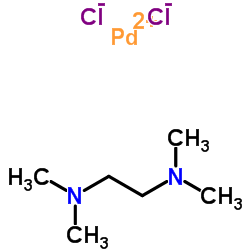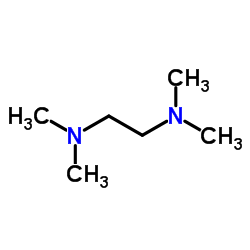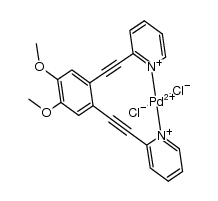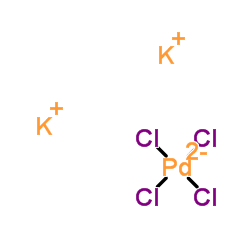Dichloro(N,N,N',N'-tetramethylethylenediamine)palladium(II)

Dichloro(N,N,N',N'-tetramethylethylenediamine)palladium(II) structure
|
Common Name | Dichloro(N,N,N',N'-tetramethylethylenediamine)palladium(II) | ||
|---|---|---|---|---|
| CAS Number | 14267-08-4 | Molecular Weight | 293.531 | |
| Density | N/A | Boiling Point | 121ºC at 760 mmHg | |
| Molecular Formula | C6H16Cl2N2Pd | Melting Point | 245ºC (dec.)(lit.) | |
| MSDS | Chinese USA | Flash Point | 10ºC | |
| Symbol |

GHS07 |
Signal Word | Warning | |
| Name | Dichloro(N,N,N′,N′-tetramethylethylenediamine)palladium(II) |
|---|---|
| Synonym | More Synonyms |
| Boiling Point | 121ºC at 760 mmHg |
|---|---|
| Melting Point | 245ºC (dec.)(lit.) |
| Molecular Formula | C6H16Cl2N2Pd |
| Molecular Weight | 293.531 |
| Flash Point | 10ºC |
| Exact Mass | 291.972534 |
| PSA | 6.48000 |
| LogP | 1.48860 |
| Vapour Pressure | 14.9mmHg at 25°C |
| InChIKey | FJOUSQLMIDWVAY-UHFFFAOYSA-L |
| SMILES | CN(C)CCN(C)C.[Cl-].[Cl-].[Pd+2] |
|
Section 1: Product Identification Chemical Name:cis-Dichloro(N,N,N'N'-tetramethylethylenediamine)palladium(II), 99% CAS Registry Number:14267-08-4 Formula:C6H16Cl2N2Pd EINECS Number:none Chemical Family:organometallic complex Synonym:cis-ichloroN,N,N',N'-Tetramethyl-ethane-1,2-diamine)palladium(II)
Section 2: Composition and Information on Ingredients IngredientCAS NumberPercentACGIH (TWA)OSHA (PEL) Title compound14267-08-4100%no datano data Section 3: Hazards Identification Emergency Overview:Irritating to skin, eyes and respiratory tract. Primary Routes of Exposure:Ingestion, inhalation Eye Contact:Causes slight to mild irritation of the eyes. Skin Contact:Causes slight to mild irritation of the skin. Inhalation:Irritating to the nose, mucous membranes and respiratory tract. Ingestion:No information available on the physiological effects of ingestion. May be harmful if swallowed. Acute Health Affects:Irritating to skin, eyes and respiratory tract. Chronic Health Affects:No information on long-term chronic effects. NTP:No IARC:No OSHA:No SECTION 4: First Aid Measures Immediately flush the eyes with copious amounts of water for at least 10-15 minutes. A victim may need Eye Exposure: assistance in keeping their eye lids open. Get immediate medical attention. Wash the affected area with water. Remove contaminated clothes if necessary. Seek medical assistance if Skin Exposure: irritation persists. Remove the victim to fresh air. Closely monitor the victim for signs of respiratory problems, such as difficulty Inhalation: in breathing, coughing, wheezing, or pain. In such cases seek immediate medical assistance. Seek medical attention immediately. Keep the victim calm. Give the victim water (only if conscious). Induce Ingestion: vomiting only if directed by medical personnel. SECTION 5: Fire Fighting Measures Flash Point:no data Autoignition Temperature:no data Explosion Limits:no data Extinguishing Medium:carbon dioxide, dry powder or foam If this product is involved in a fire, fire fighters should be equipped with a NIOSH approved positive pressure Special Fire Fighting Procedures: self-contained breathing apparatus and full protective clothing. Hazardous Combustion andIf involved in a fire this material may emit toxic organic fumes. Decomposion Products: Unusual Fire or Explosion Hazards: No unusual fire or explosion hazards. SECTION 6: Accidental Release Measures Spill and Leak Procedures:Small spills can be mixed with vermiculite or sodium carbonate and swept up. SECTION 7: Handling and Storage Handling and Storage:Store in a tightly sealed container. Keep in a cool, dry, well ventilated place. SECTION 8: Exposure Controls and Personal Protection Eye Protection:Always wear approved safety glasses when handling a chemical substance in the laboratory. Skin Protection:Wear protective clothing and gloves. Ventilation:Handle the material in an efficient fume hood. If ventilation is not available a respirator should be worn. The use of respirators requires a Respirator Respirator: Protection Program to be in compliance with 29 CFR 1910.134. Ventilation:Handle the material in an efficient fume hood. Additional Protection:No additional protection required. SECTION 9: Physical and Chemical Properties Color and Form:yellow powder Molecular Weight:293.53 Melting Point:no data Boiling Point:no data Vapor Pressure:no data Specific Gravity:no data Odor:not determined Solubility in Water:insoluble SECTION 10: Stability and Reactivity Stability:air and moisture stable Hazardous Polymerization:no hazardous polymerization Conditions to Avoid:none Incompatibility:strong oxidizing agents Decomposition Products:carbon monoxide, carbon dioxide, palladium oxide and organic fumes SECTION 11: Toxicological Information RTECS Data:No information available in the RTECS files. Carcinogenic Effects:no data Mutagenic Effects:no data Tetratogenic Effects:no data SECTION 12: Ecological Information Ecological Information:No information available SECTION 13: Disposal Considerations Disposal:Dispose of according to local, state and federal regulations. SECTION 14: Transportation Shipping Name (CFR):Non-hazardous Hazard Class (CFR):NA Additional Hazard Class (CFR):NA Packaging Group (CFR):NA UN ID Number (CFR):NA Shipping Name (IATA):Non-hazardous Hazard Class (IATA):NA Additional Hazard Class (IATA):NA Packaging Group (IATA):NA UN ID Number (IATA):NA SECTION 15: Regulatory Information TSCA:Not listed in the TSCA inventory SARA (Title 313):Title compound not listed Second Ingredient:none SECTION 16 - ADDITIONAL INFORMATION N/A |
| Symbol |

GHS07 |
|---|---|
| Signal Word | Warning |
| Hazard Statements | H315-H319-H335 |
| Precautionary Statements | P261-P305 + P351 + P338 |
| Personal Protective Equipment | dust mask type N95 (US);Eyeshields;Gloves |
| Hazard Codes | Xi: Irritant; |
| Risk Phrases | R36/37/38 |
| Safety Phrases | 37/39-26 |
| RIDADR | NONH for all modes of transport |
|
~98% 
Dichloro(N,N,N'... CAS#:14267-08-4 |
| Literature: Biscoe, Mark R.; Fors, Brett P.; Buchwald, Stephen L. Journal of the American Chemical Society, 2008 , vol. 130, # 21 p. 6686 - 6687 |
|
~97% 
Dichloro(N,N,N'... CAS#:14267-08-4 |
| Literature: Zhao, Qing; Li, Chengxi; Senanayake, Chris H.; Tang, Wenjun Chemistry - A European Journal, 2013 , vol. 19, # 7 p. 2261 - 2265 |
|
~90% 
Dichloro(N,N,N'... CAS#:14267-08-4 |
| Literature: Graaf, Wim de; Boersma, Jaap; Smeets, Wilberth J. J.; Spek, Anthony L.; Koten, Gerard van Organometallics, 1989 , vol. 8, p. 2907 - 2917 |
|
~97% 
Dichloro(N,N,N'... CAS#:14267-08-4 |
| Literature: Jung, Miso; Suzaki, Yuji; Saito, Takashi; Shimada, Kyoichi; Osakada, Kohtaro Polyhedron, 2012 , vol. 40, # 1 p. 168 - 174 |
|
~% 
Dichloro(N,N,N'... CAS#:14267-08-4 |
| Literature: Inorganic Chemistry, , vol. 31, p. 1090 - 1095 |
|
~% 
Dichloro(N,N,N'... CAS#:14267-08-4 |
| Literature: Polyhedron, , vol. 19, # 8 p. 959 - 963 |
|
~% 
Dichloro(N,N,N'... CAS#:14267-08-4 |
| Literature: Inorganica Chimica Acta, , vol. 188, p. 25 - 32 |
|
~% 
Dichloro(N,N,N'... CAS#:14267-08-4 |
| Literature: Inorganica Chimica Acta, , vol. 198 - 200, p. 187 - 192 |
| DICHLORO(N,N,N',N'-TETRAMETHYLETHYLENEDIAMINE)PALLADIUM(II) |
| MFCD00075317 |
| Palladium(2+) chloride - N,N,N',N'-tetramethyl-1,2-ethanediamine (1:2:1) |
| Palladium,dichloro(N,N,N',N'-tetramethyl-1,2-ethanediamine-N,N')-,(sp-4-2) |
| (N,N,N',N'-tetramethylethylenediamine)PdCl2 |
| dichloro(N,N,N',N'-tetramethylethylene-diamine)pa |
| [Pd(tmen)Cl2] |
| N,N,N',N'-tetramethylethylenediamine palladium(II) chloride |
| Palladium,dichloro(N,N,N',N'-tetramethylethylenediamine) |
| cis-dichloro(N,N,N',N'-tetramethylethylenediamine)palladium(II) |
| Cl2Pd(II)(TMEDA) |
| 1,2-Ethanediamine, N,N,N,N-tetramethyl-, palladium(2+) salt, hydrochloride (1:1:2) |
| (N,N,N',N'-tetramethylethylenediamine)dichloridopalladium(II) |







